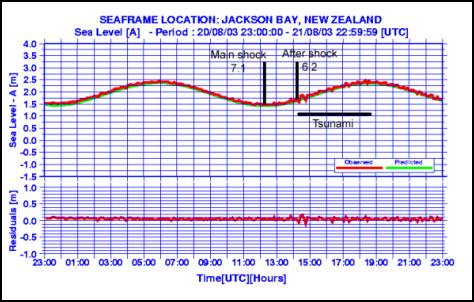Fiordland Earthquake Generated Small Tsunami
Media Release
22 Sept, 03
http://unipr.waikato.ac.nz
Last night’s earthquake off the coast of Fiordland generated a small tsunami that was recorded in Westland. The earthquake was similar in size to the one that caused the catastrophic tsunami at Sissano on the northern coast of Papua New Guinea in 1998.
A tsunami was also generated after the New Zealand earthquake, and recorded on the SEAFRAME sea level station in Jackson Bay near Haast. This station is operated by the National Tidal Facility at Flinders University, Adelaide, and they have provided the graph below. Marked on the graph are the times of the main shock and the largest aftershock, and the tsunami. The station is intended to monitor long-term changes in sea level, and is not ideal for measuring tsunami, but indicates a wave with amplitude of 15 cm and period of about 25 minutes. It also appears that the tsunami was generated by the largest aftershock, as the tide gauge is within a few minutes tsunami travel time from the epicentre of the earthquake.

An interesting problem for researchers and emergency managers is why was the Sissano so large, while this one is small. Dr de Lange from Earth Sciences in University of Waikato is shortly to present a paper at the Coasts and Ports Australasian Conference in Auckland dealing with this issue. He is discussing simple methods to predict the maximum tsunami wave height around the New Zealand coast. The method for earthquake tsunami suggest that the maximum height that the main shock could have produced is 1.8 m, while the main after shock could generate up to a 0.6 m high tsunami. This suggests that the tsunami at Jackson Bay is consistent in size with the aftershock.
The methods he is presenting also deal with landslide-generated tsunami. Submarine landslides triggered by an earthquake can generate much larger tsunami than would expected for any given earthquake magnitude. In the Sissano event, the consensus view is that a submarine landslide was responsible for the killer tsunami. For New Zealand, available data suggest that at least a magnitude 7.3 earthquake is need to directly generate a deadly tsunami. However, if an earthquake was to trigger a landslide, then the minimum magnitude is only 4.5.
ENDS


 John Mazenier: Gaffer Tape And Glue Delivering New Zealand’s Mission Critical Services
John Mazenier: Gaffer Tape And Glue Delivering New Zealand’s Mission Critical Services Earthquake Commission: Ivan Skinner Award Winner Inspired By Real-life Earthquake Experience
Earthquake Commission: Ivan Skinner Award Winner Inspired By Real-life Earthquake Experience Reserve Bank: Consultation Opens On A Digital Currency For New Zealand
Reserve Bank: Consultation Opens On A Digital Currency For New Zealand NIWA: Ship Anchors May Cause Extensive And Long-lasting Damage To The Seafloor, According To New Research
NIWA: Ship Anchors May Cause Extensive And Long-lasting Damage To The Seafloor, According To New Research New Zealand Customs Service: A Step Forward For Simpler Trade Between New Zealand And Singapore
New Zealand Customs Service: A Step Forward For Simpler Trade Between New Zealand And Singapore Horizon Research: 68% Say Make Banks Offer Fraud Protection
Horizon Research: 68% Say Make Banks Offer Fraud Protection



